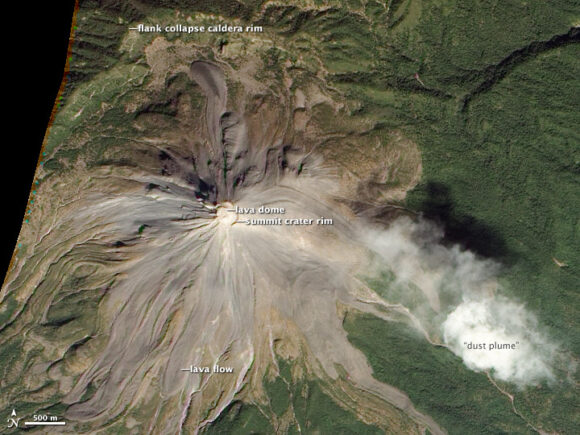In our series of brief updates on topics featured in previous Geo-Mexico posts, we look this week at the continuing eruption of two major volcanoes: Popocatapetl Volcano (between Mexico City and Puebla) and Colima Volcano (on the Jalisco-Colima state border in western Mexico).
Since our previous post, about a year ago, entitled Alert level rises as Popocatepetl volcano starts to erupt, Popocatapetl Volcano (photo) has continued to be active, with up to 250 activity events a day. The alert level has been reduced slightly to Yellow Phase 2, the fourth highest level. This level indicates intermediate scale explosive activity and possible expulsion of lava, explosions of increasing intensity and wind-blown ash falling on nearby villages. The volcano is monitored daily, and updates from CENAPRED (in Spanish and English) are issued every 24 hours.
The report issued on 27 March is typical of recent months. In the previous 24 hours, there were 83 low intensity events with emissions of gas, water vapor and ash. The two largest events sent material rising 1000 meters and 600 meters into the atmosphere respectively, before the wind blew the material north eastwards (away from Mexico City).
Colima Volcano
In January 2013, we reported how Colima Volcano erupts, destroying lava dome first created in 2007. The volcano has continued to erupt in the ten weeks since then. The experts monitoring the volcano have reported up to 200 eruptive events a day, with numerous minor emissions of lava. Local villagers have been asked to remain on alert, though the experts are not yet calling for any villages to be evacuated.
- Spectacular LANDSAT image of Colima Volcano, taken in 2003 (Nasa Earth Observatory)
- View of Colima Volcano from the International Space Station in 2005
The image below (source: Nasa Earth Observatory) shows Colima Volcano in 2010, part way into its current eruptive phase which is expected to last several years. The image shows the evidence at that time of four different types of volcanic activity:
- lava dome growth
- explosive eruptions
- flank collapse
- lava flows.
(Note that the 2013 eruptions have significantly altered the top of the volcano since this image was taken).
Related posts:
- Paricutin Volcano in Mexico celebrates its 70th birthday
- Mexico’s highest volcanoes
- Mexico’s geomorphosites: the volcanic spine of Tequila Volcano, Jalisco
- The eruption of El Chichón volcano in 1982
- How has the movement of tectonic plates affected Mexico?
- Mexico’s Volcanic Axis
- In Mexico, even the volcanoes have microwaves…
- The mud volcanoes known as Los Negritos, in Michoacán, Mexico
- The world’s smallest volcano is in Puebla, Mexico


Sorry, the comment form is closed at this time.